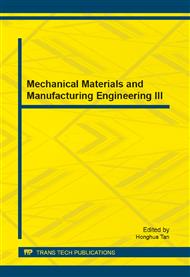[1]
iNEMI, Electronics Manufacturing Initiative Technology Roadmap, 2004. (http: /www. nemi. org).
Google Scholar
[2]
A. Watwe and R. Viswanath, Proceedings of Pacific Rim/ASME International Electronic Packaging Technical Conference and Exhibition (InterPack'03), 2003 (unpublished), Paper No. 2003-35004.
Google Scholar
[3]
S. Sinha, P. K. Schelling, S. R. Phillpot, and K. E. Goodson, J. Appl. Phys. 97, 023702 (2002).
Google Scholar
[4]
B. Yang, P. Wang, and A. Bar-Cohen, IEEE Trans. Compon. Packag. Technol. (in press).
Google Scholar
[5]
T. C. Harman, P. J. Taylor, M. P. Walsh, and B. E. Laforge, Science 297, 2229 (2002).
Google Scholar
[6]
B. Yang, P. Wang, and A. Bar-Cohen, Proceedings of the 56th Electronic Components and Technology Conference (ECTC-56), 2006 (unpublished), pp.997-1002.
Google Scholar
[7]
R. Venkatasubramanian, E. Siivola, T. Colpitts, and B. O'Quinn, Nature (London) 413, 597 (2001).
Google Scholar
[8]
P. Wang, A. Bar-Cohen and B, Yang, Proceedings of Pacific Rim/ASME International Electronic Packaging Technical Conference and Exhibition (InterPack'07), 2003 (unpublished), Paper No. IPACK2007-33798.
Google Scholar
[9]
X. Fan, G. Zeng, C. LaBounty, J. Bowers, E. Croke, C. Ahn, S. Huxtable, and A. Majumdar, Appl. Phys. Lett. 78, 1580 (2002).
DOI: 10.1063/1.1356455
Google Scholar
[10]
Tuckerman, D. B., and Pease, R. F. W., 1981, High Performance Heat Sinking for VLSI, IEEE Electron Device Lett., 2, p.126–129.
DOI: 10.1109/edl.1981.25367
Google Scholar
[11]
Sobhan, C. B., and Garimella, S. V., 2001, A Comparative Analysis of Studies on Heat Transfer and Fluid Flow in Microchannels, Microscale Thermophys. Eng., 5, p.293–311.
DOI: 10.1080/10893950152646759
Google Scholar
[12]
Qu, W., and Mudawar, I., 2002, Experimental and Numerical Study of Pressure Drop and Heat Transfer in a Single-Phase Micro-Channel Heat Sink, Int. J. Heat Mass Transfer, 45, p.2549–2565.
DOI: 10.1016/s0017-9310(01)00337-4
Google Scholar
[13]
Bejan, A., and Errera, M. R., 1997, Deterministic Tree Networks for Fluid Flow: Geometry for Minimal Flow Resistance Between a Volume and One Point, Fractals, 5, p.685–695.
DOI: 10.1142/s0218348x97000553
Google Scholar
[14]
Bejan, A., 2001, The Tree of Convective Heat Streams: Its Thermal Insulation Function and the Predicted 3/4-Power Relation Between Body Heat Loss and Body Size, Int. J. Heat Mass Transfer, 44, p.699–704.
DOI: 10.1016/s0017-9310(00)00138-1
Google Scholar
[15]
Chen, Y., and Cheng, P., 2002, Heat Transfer and Pressure Drop in Fractal Tree-Like Microchannel Nets, Int. J. Heat Mass Transfer, 45, p.2643–2648.
DOI: 10.1016/s0017-9310(02)00013-3
Google Scholar


